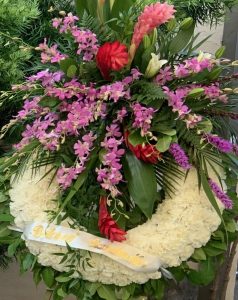
By Rev. Ken Yamada
A thousand years ago, a kind of Buddhist last rites in Japan became popular—family members gathered around a dying person, together chanting “Namu Amida Butsu.” These deathbed rituals helped send the person to the Pure Land, or so they thought.
Maybe it’s time to bring back these rituals.
I’m joking, but calmly contemplating the Pure Land isn’t such a bad idea considering the more common end-of-life scenario—over-reliance on medical technology.
A medical doctor, Atul Gawande, wrote eloquently on the subject in the book, “Being Mortal,” and also in the New Yorker called “Letting go: What should medicine do when it can’t save your life,” (issue: Aug. 2, 2011):
Spending one’s final days in an intensive care unit because of terminal illness is for most people a kind of failure. You lie on a ventilator, your every organ shutting down, your mind teetering on delirium… The end comes with no chance for you to have said goodbye or “It’s okay” or “I’m sorry” or “I love you.”
Don’t get me wrong: today’s medicine treats what was once incurable, heals many illnesses, re-sets broken bones and offers relief from pain. There is definitely a time and a place for medical treatment and doing all you can to overcome illness. What modern medicine cannot do is provide a cure for death. Understanding that difference is crucial.
Gawande cites a study, which showed that “terminally ill cancer patients who were put on a mechanical ventilator, given electrical defibrillation or chest compressions, or admitted, near death, to intensive care had a substantially worse quality of life in their last week than those who received no such interventions. And, six months after their death, their caregivers were three times as likely to suffer major depression.”
Such findings highlight the problems created by modern medicine, which brings to mind the adage “the cure is sometimes worse than the disease.” As a Buddhist priest, I regularly made hospital visits, sometimes at this final stage, and have witnessed such suffering, to which there are no easy answers.
Naturally, end-of-life patients and their families often search desperately for new drugs, treatments and procedures, which according to Gawande, essentially all end in failure. Patients don’t accept the fact they are dying, which they feel is tantamount to “giving up,” or else, family members insist on radical treatments that inflict even more pain, hoping for a miracle recovery or at least a longer life span down the road.
Almost counter-intuitively, hospice care—forgoing treatment of a disease in favor of just treating immediate symptoms to ensure the best quality of life now—had some surprising results. Hospice care workers also address the topic of death with patients and families, discussing their needs, desires and priorities.
Research found no difference in survival times between hospice and non-hospice patience with certain cancers. In fact, some hospice patients lived longer, anywhere from a few weeks to a few months longer. Gawande wrote, “The lesson seems almost Zen: you live longer only when you stop trying to live longer.”
According to the study, these hospice patients “suffered less, were physically more capable, and were better able, for a longer period, to interact with others. Moreover, six months after the patients died their family members were much less likely to experience major depression. In other words, people who had substantive discussions with their doctor about their end-of-life preferences were far more likely to die at peace and in control of their situation and to spare their family anguish.”
However, even this last peaceful scenario is not guaranteed. The Buddha explained that life flows from innumerable interdependent causes and conditions beyond our control. Impermanence too is a universal truth, felt most strongly when facing the great change we call “death.”
I think beyond our physical worries lies a greater and more deeply imbedded anxiety. It’s a fear we need to confront most, but which we work hardest to avoid. It’s the fear of death.
Our Jodo Shinshu Buddhist tradition tells the story of a Chinese Buddhist monk T’an-luan (476-542), who fell ill and suddenly became afraid of dying. Shinran Shonin paid homage to T’an-luan in his hymns called Shoshinge, which we regularly chant.
T’an-luan hurried off to study the secrets of eternal life and longevity with a famous Taoist master. When returning with some scrolls on a path to his village, he encountered the Indian monk Bodhiruci. He asked the teacher about Buddhist practices for eternal life.
Bodhiruci spat and said something like, “You fool! If you live 10,000 years, you will die. If you live 1,000 years, you will die. If you live, 100 years, you will die. The real problem you face is how to live right now.” Instead, he told the monk, learn the Pure Land way. T’an-luan abandoned the Taoist scrolls and ultimately burned them.
T’an-luan learned the true meaning of “eternal life.” In understanding this life and the connection to all things and all lives, past and future, he realized that the infinite lies in this moment, for this moment contains the eternity of time. Appreciating your life now is most precious.
Each person’s life is unique, each of our circumstances, karma, is different. There is no one right course to follow. However, if our desires and actions are driven by fear and anxiety, then we assuredly will suffer.
By gaining a spiritually deep sense of peace, then whatever happens in life we may calmly accept. The Buddha taught that each of us has the potential to gain this peace by awakening to the true meaning of our life. This potential exists as long as we are alive. Consequently, each breath is important, each moment is important. We can live this life fully, no matter how long or how short. This is the meaning behind the words: realizing our birth in the Pure Land.
-Rev. Yamada is editor at Higashi Honganji’s Shinshu Center of America

